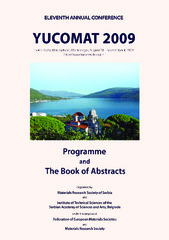Приказ основних података о документу
Role of Phase Imaging in Surface Roughness Analysis of Biopolymers
| dc.creator | Bojović, Božica | |
| dc.creator | Miljković, Zoran | |
| dc.creator | Babić, Bojan | |
| dc.creator | Kojić, Dušan | |
| dc.date.accessioned | 2023-03-18T17:43:18Z | |
| dc.date.available | 2023-03-18T17:43:18Z | |
| dc.date.issued | 2009 | |
| dc.identifier.isbn | 978-86-80321-18-9 | |
| dc.identifier.uri | https://machinery.mas.bg.ac.rs/handle/123456789/6553 | |
| dc.description.abstract | Phase image features are as easy to perceive, distinguish and accept as the eye can see. In surface technology, differences in contour and colour on a phase image can be used either for topography image's validation checking or for the better understanding of surface generation process. This paper describes the methodology of rough surface analyses and the role that the phase images has in them. Two surfaces of same biomaterial were polished under different conditions. Polished surfaces were prepared and recorded by scanning probe microscopy in the only appropriate mode for delicate materials such as biomaterials - the tapping mode. Simultaneously gathered topography and phase images were analysed in order to observe measuring errors and choose topographic images suitable for standard and fractal roughness analyses. First, surface roughness of selected topographic images was analysed by standard roughness parameters. Laboratory microscope JEOL SPM5200 has accompanied software WinSPM for image analyses. Standard surface roughness analysis was also conducted using this software. Surfaces’ roughnesses were evaluated based on a number of parameters correlated to surface profile or surface area. In addition, phase image also provided useful information for fractal analysis. Topographic images were attached to ASCII files with data that represent surface height in every pixel of recorded image. Based on phase image analysis results, checked and accepted topography images were loaded in Matlab custom-made procedures for fractal analysis. Fractal analysis based on modified “skyscrapers” method, set up in previous research, provides fractal dimensions for polished surfaces' images. Based on the fact that machined surface with larger fractal dimension is rougher than the one with the lower value, on the one hand, and that there is an optimal value for good functional behaviour, on the other hand, final decision on surface quality can be arrived at. As a result of two surfaces' roughness quantification, two values of fractal dimension are used for surface characterisation, comparison and functional behaviour prediction. Authors underline the effectiveness of phase image in surface roughness analyses, either conventional or fractal one. At the same time, the authors consider fractal analysis as more suitable for identification, comparison and functional behaviour prediction when compared to the conventional one. Fractal analysis conclusions can constitute valuable feed-back information for manufacturing process, and in this case, could influence the selection for optimal polishing duration. | sr |
| dc.language.iso | en | sr |
| dc.publisher | Institute of Technical Sciences of the Serbian Academy of Sciences and Arts, Belgrade | sr |
| dc.relation | info:eu-repo/grantAgreement/MESTD/MPN2006-2010/14031/RS// | sr |
| dc.rights | openAccess | sr |
| dc.rights.uri | https://creativecommons.org/share-your-work/public-domain/cc0/ | |
| dc.source | 11th Annual Conference ”YUCOMAT 2009”, Poster session, The Book of Abstracts | sr |
| dc.subject | Phase Imaging | sr |
| dc.subject | Surface Roughness Analysis of Biopolymers | sr |
| dc.subject | Scanning probe microscopy JEOL SPM5200 | sr |
| dc.subject | Biomaterials - the tapping mode | sr |
| dc.subject | Topographic images | sr |
| dc.subject | WinSPM software for image analyses and standard surface roughness analysis | sr |
| dc.subject | Matlab custom-made procedures for fractal analysis | sr |
| dc.subject | Fractal analysis based on modified “skyscrapers” method | sr |
| dc.subject | Fractal dimension | sr |
| dc.subject | Surface characterisation | sr |
| dc.subject | The manufacturing process | sr |
| dc.subject | Optimal polishing of the biomaterial | sr |
| dc.title | Role of Phase Imaging in Surface Roughness Analysis of Biopolymers | sr |
| dc.type | conferenceObject | sr |
| dc.rights.license | CC0 | sr |
| dc.rights.holder | Prof. Dragan P. Uskoković | sr |
| dc.citation.epage | 189 | |
| dc.citation.rank | M34 | |
| dc.citation.spage | 189 | |
| dc.identifier.fulltext | http://machinery.mas.bg.ac.rs/bitstream/id/16539/bitstream_16539.pdf | |
| dc.identifier.rcub | https://hdl.handle.net/21.15107/rcub_machinery_6553 | |
| dc.type.version | publishedVersion | sr |


